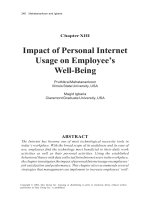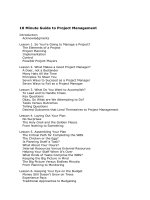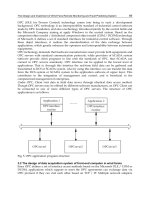Time Management Part 7 doc
Bạn đang xem bản rút gọn của tài liệu. Xem và tải ngay bản đầy đủ của tài liệu tại đây (240.22 KB, 12 trang )
I
t’s 7 p.m. You’ve settled down to a nice, quiet dinner at
home. The phone rings.
“Hello, is this John Smith?”
“Yes,” you answer.
“How are you this evening?”
“Fine,” you respond, watching your food get cold and
wondering who this is.
“As a fellow graduate of the East Overshoe University, I’m
sure you’ve kept up on our recent successes. And you’ve
certainly been supportive of our efforts to continue that
tradition of quality. That’s why we thought you’d like to
know about our new fundraising drive ”
Maybe you’d like to contribute to old EOU. Maybe not. It’s
hard to say no to this eager young voice. And you’re even
willing to forgive this interruption of your personal life and
the manipulative way that caller has “reeled” you in.
81
Learning
to Say
No
7
Mancini07.qxd 1/16/2003 4:35 PM Page 81
Copyright © 2003 by the McGraw-Hill Companies, Inc. Click here for Terms of Use.
Telemarketers know that it’s hard to say no. Indeed, they
prey on our politeness—those dinner interruptions aren’t just for
the old alma mater but also for timeshares, opinion polls,
investment schemes, and sales pitches for all types of products.
Such calls have become so common that there are now compa-
nies that, for a fee, will work to take you off telemarketing lists.
Now that’s an investment idea.
It’s not just telemarketers, either. Friends, fellow workers,
and others often place subtle (and sometimes not so subtle)
demands on our time and energy. If, out of politeness, we
acquiesce to all these demands, we subject ourselves to drain-
ing levels of stress. The result: our performance in all areas suf-
fers. Sometimes we just need to say no to those who make
requests or demands of us.
Saying no is exceedingly difficult, though, isn’t it? It takes
willpower. Indeed, in an age when most people are already too
burdened with obligations, to learn when and how to say no
becomes one of the most crucial skills you can acquire.
Time Management82
Managing Mail
Here are a few tactics to help you say no to intrusions on
your time through the mail:
• Throw away or shred any piece of mail that’s clearly “junk.” Don’t
even bother to open it. (Direct mail experts know this, of course,
so they often put something that looks like a check behind the cel-
lophane envelope window that makes you afraid not to open it.)
• Cancel subscriptions to publications you rarely get around to read-
ing.
• Contact the Direct Marketing Association (1120 Avenue of the
Americas, New York, NY 10036-6700 or www.the-dma.org) to
obtain forms that can help you limit the flow of unwanted mail to
your office or home.
• Skim all “wanted” magazines for relevant articles, highlighting or
underlining key points. If you don’t have time to read them, tear out
important articles and file them for future reference.
• Discard any topical magazine that’s more than a few months old.
You’ll never get to it anyway.
Mancini07.qxd 1/16/2003 4:35 PM Page 82
What to Say No to
Robert Moskowitz, author of How to Organize Your Work and
Your Life (New York: Doubleday, 1993, 2nd edition), identified
two vital questions to ask yourself before saying yes to some-
thing you might feel reluctant about:
1. What will this commitment mean? Let’s say you’ve been
asked to serve on a committee. Before saying yes, you
need answers to all the following questions:
• When does it meet?
• How often does it meet?
• How long are the meetings?
• What does it do?
• What would my responsibilities be?
• Are there any allied duties outside the meeting time?
• How long would I be expected to serve on this committee?
So, before you agree to do anything, try to anticipate
any unvoiced or unexpected responsibilities that may
emerge later on.
2. If you had to take on this commitment tomorrow, would
it—considering what you’ve planned—be a good use of
your time? Moskowitz considers this the litmus test of
responsibility. When compared with your normal duties,
does the project obligation seem worthy? If yes, then it
merits your time. If not (and assuming tomorrow
Learning to Say No 83
A Different Way
Of course, you don’t have to do everything everyone wants
you to do. But you also don’t have to do everything the way
everyone wants you to do it, either.
If you know there’s a better, less time-consuming way to produce
the same results, you should learn to say no to the approach others
typically use. Be confident in the way you work best. After all, once
you find a method of producing satisfactory results in your own way,
you might be able to say yes to a request you might otherwise have
turned down.
Saying no to the how may make it possible to say yes to the what.
Mancini07.qxd 1/16/2003 4:35 PM Page 83
is not the most critical day of the year), then maybe you
should say no.
How to Say No
Psychologists have identified a four-step procedure that makes
saying no safe, diplomatic, and effective:
• Give a reason. To simply decline to do something seems
arbitrary, lazy, or irresponsible. If you give a good, solid rea-
son for your decision, it will show that you’re reasonable.
• Be diplomatic. Saying no can hurt, upset, or even anger
the person to whom you’re saying it. Tact is essential
when turning down anything.
Time Management84
Say No to Information Overload
We live in an age of information overload. But you can
control how you receive and process information by
focusing on what you need and rejecting what you don’t. Here are a
few tips:
• When reading a report, read the executive summary first. Skim what
follows only to sift out necessary details. If you can influence the
people creating reports, insist that they have executive summaries.
• Subscribe to publications that summarize facts, books, articles, etc. A
few examples:
Executive Book Summaries
Wellness Letter (UC Berkeley)
Kiplinger Washington Letter
• Avoid real-time TV viewing. Tape TV shows and fast-forward past com-
mercials.
• Use the bookmark feature on your Internet browser to store infor-
mation sites you use frequently.
• Get a voice-mail system that limits messages to one minute and does-
n’t record hang-ups. Whether or not you have a limiting feature on
your equipment, warn callers in your outgoing message that they
have 60 seconds to state their message. (Yes, they may call back and
leave a continuation of their message, but the second attempt will
be far more compact than the first.)
Mancini07.qxd 1/16/2003 4:35 PM Page 84
• Suggest a trade-off. If you explain that you’re willing to
find some other way to contribute, you’ll underscore your
goodwill. For example, if your boss suggests you do
something and you’re convinced that you’re the wrong
person to do it, explain your perceptions and suggest tak-
ing on another task that you know needs to be done.
• Don’t put off your decision. “Let me think it over ” is
probably the most common way for people to postpone
an inevitable “no.” And it’s utterly unfair. Be courageous.
If you know that you cannot or will not do something, be
decisive and say it, then and there. Delaying a decision is
only justified in intricate situations.
An Exercise
Make a list of current responsibilities to which you probably
should have said no. How might hindsight have made you do
things differently? Does this suggest any resolutions for the
future? One reminder: unfortunately, there are things
you’d probably like to say
no to that, for “political”
reasons, require a yes.
Dealing with Meetings
and Committees
“A meeting,” said one pun-
dit, “is an event at which
the minutes are kept and
the hours are lost.”
The average executive
spends half of his or her
week in meetings. Of this,
about six hours’ worth,
according to several stud-
ies, is rated as totally
unnecessary. Yet, in many
businesses, meetings have
Learning to Say No 85
How Not to Take No
for an Answer
Of course, the opposite problem of
learning how to say no is getting oth-
ers to say yes.The solution is persist-
ence.
In sales, the single most common
reason for failure to close the deal is
that the salesperson never asks for
the business.The seller tiptoes
around the question, never coming
right out and asking the customer to
say yes. And, when the first response
is no, even those salespeople who
bothered to ask tend to give up.
You need to be able to say no and
mean it, but you may have to be per-
sistent enough to get others to say
yes.
Mancini07.qxd 1/16/2003 4:35 PM Page 85
become a ritual and committees are a duty, so that it’s nearly
impossible to say no to them.
Your job: to ensure that the meetings you attend result in a
sleek, productive use of everyone’s time. If you run the meet-
ing, your task requires commitment to time management prin-
ciples. If you’re a participant, your challenge is more acute: to
subtly guide the group to productive activity. Here are 12 guide-
lines that will help you increase a meeting’s productivity.
1. Create a written agenda for each meeting. Make sure it’s dis-
tributed to all participants at least 24 hours in advance. (Figure
7-1 shows a sample agenda form.) If you’re asked to attend a
meeting scheduled by someone else, request that he or she pro-
Time Management86
To _______________________ Meeting Date ____________________
From _____________________ Start Time ______________________
Mailing Date _______________ End Time _______________________
# Attached Pages ___________ Location ________________________
Topics to Be Covered (in order) Presented By Time
1. ________________________ __________________ __________
2. ________________________ __________________ __________
3. ________________________ __________________ __________
4. ________________________ __________________ __________
5. ________________________ __________________ __________
6. ________________________ __________________ __________
7. ________________________ __________________ __________
8. ________________________ __________________ __________
Key Meeting Objectives/Goals
Premeeting Preparation
Figure 7-1. Sample meeting agenda form
Mancini07.qxd 1/16/2003 4:35 PM Page 86
TEAMFLY
Team-Fly
®
vide you with a written agenda in advance.
2. Assign the meeting a clear start time. Check for conference
room availability. Equally important: the meeting shouldn’t be
delayed for late arrivals. Participants will soon learn that you
expect them to be prompt. (Of course, leave room for excep-
tional circumstances or essential people.)
3. Assign an official closing time to the meeting. Open-ended
meetings can drag on, with participants mired in trivial or ancil-
lary concerns. A tight finish time disciplines participants to work
more efficiently and with fewer tangents. Shorter meetings tend
to concentrate discussions on the real goals of the meeting and
keep it focused. If the meeting length must expand, it should be
by the consensus of all the participants. And if the meeting was
scheduled by someone else, ask that he or she set a finish time.
4. Set at least one goal for your meeting. A meeting without
clear objectives is rudderless. A committee meeting should
have a “para-goal.” Concentrate on how the meeting should
achieve the component objectives of that goal.
5. Be reasonable about the number of topics to be covered.
Having established a start time, a finish time, and a set of goals,
you should be able to designate a reasonable number of sub-
jects for discussion. An agenda too tight with topics is doomed
from the start. If you must cover a sizable number of themes,
consider the following:
• Establish a later finish time.
• Postpone less important priorities to the next meeting.
• Divide your meeting into simultaneous or separate sub-
meetings that deal with fewer topics.
• Create a separate meeting during which the whole group
will tackle what cannot be covered in the time allotted.
6. Invite only the necessary people. People who plan meetings
often feel they should invite everyone even remotely interested
in what’s going on. This is a serious mistake. The time it takes
to get things done in a meeting expands geometrically with the
Learning to Say No 87
Mancini07.qxd 1/16/2003 4:35 PM Page 87
number of its participants. Be merciless when inviting people to
attend. An observation: meetings and committees function best
with six members at most. With more, the gathering becomes
less productive and more of a forum for views. Generally, the
true, often unstated purpose of such a large meeting is to pro-
tect democratic decision making (or, at least, its image).
7. Never schedule a meeting because it’s customary. Many
companies have the weekly “Monday morning conference.”
Many need it—but does yours? Or do most regularly scheduled
meetings encourage people at your workplace to think up
things to say? If so, it might be time to reconsider that tradition.
In effect, you’ll be saying no to an obligation that, ultimately,
may have minimal value.
8. Never require a group of people to work on something that
one person could do just as easily. Before you schedule any
meeting, add up the hourly salaries of all participants and multi-
ply that number by the projected meeting duration. That will
sober you up. It will also open up alternatives, like canceling the
meeting in favor of proposals that get circulated to all relevant
personnel for comments.
9. Create an environment for productivity. Use the checklist of
environmental factors (sidebar) prior to your next meeting.
Time Management88
Checklist of Environmental
Factors for a Meeting
❏ Is lighting conducive to productivity and mood?
❏ Would a room with windows open up the space or lead to distrac-
tions?
❏ Does the configuration of the table encourage good work commu-
nication?
❏ Are the chairs comfortable?
❏ Is the temperature favorable for concentration?
❏ Are audiovisuals in place?
❏ Do drinks, snacks, and décor make the room user-friendly?
❏ Is the room free from all but essential interruptions?
Mancini07.qxd 1/16/2003 4:35 PM Page 88
10. Establish an idea bin. On a flipchart, transparency, or white-
board, list all ideas that the meeting generates. Doing so can
also guide the person who is taking the official notes.
An interesting variation: create a “tangent bin” flipchart
sheet (tape it to the wall). All tangents should be listed on it
and, time permitting, they can be taken up toward the meet-
ing’s end. This is a powerful way to diffuse digressions.
11. At the meeting’s close, orally summarize all agreements,
assignments, and decisions. Consensus is integral to a meet-
ing’s success. This is also the time for participants to pose clari-
fying questions, to fill out any details missing from the group’s
action plan, to reinforce accomplishments, and, if appropriate,
to set the next meeting.
12. Via a written meeting summary, list all steps to be taken to
fulfill the meeting’s consensus. The Meeting Summary Form
(Figure 7-2, page 90) provides you with a document to pin
down agreed-upon efforts, assignments, and deadlines. In
essence, it’s a pared-down, action-oriented version of the vener-
able minutes. Figure 7-3 (page 91) summarizes the steps of an
effective meeting.
If You’re Not the Chairperson
All these guidelines for better meetings seem useful. But sup-
pose you’re just a participant? How can you get the person run-
ning things to do it more time-efficiently?
Perhaps you can volunteer to do certain things to facilitate
efficiency. For example, you might offer to provide an agenda
form or to take minutes and translate them into a meeting sum-
mary. Maybe you could suggest that the next meeting have an
official finish time or that an “idea bin” would be useful. If you
can’t say no to a meeting, you can at least say yes to more effi-
cient and vigorous meetings by using initiative and setting an
example.
Learning to Say No 89
Mancini07.qxd 1/16/2003 4:35 PM Page 89
Conclusion
To say no is difficult, but it’s sometimes necessary. If you evalu-
ate the ways you spend your time meeting and pursuing infor-
mation, though, you can indeed learn to be discriminating and
more productive. Another effective method of saying no
involves learning to anticipate the unexpected. Forewarned is
forearmed, after all. That indispensable art of anticipating is the
subject of Chapter 8.
Time Management90
Meeting Title: Attendees: ___________________
Meeting Date: ___________________
Chaired by: ___________________
Recorded by: ___________________
___________________
___________________
___________________
Persons Responsible
Actions Agreed Upon (Initials) Deadline
1. ________________________ __________________ __________
2. ________________________ __________________ __________
3. ________________________ __________________ __________
4. ________________________ __________________ __________
5. ________________________ __________________ __________
6. ________________________ __________________ __________
7. ________________________ __________________ __________
8. ________________________ __________________ __________
Topic Postponed: Next Meeting Date: _______________
Start Time: ______________________
End Time: _______________________
❏ Last meeting’s agenda attached
❏ Next meeting’s agenda attached
Figure 7-2. Meeting summary
Mancini07.qxd 1/16/2003 4:35 PM Page 90
Manager’s Checklist for Chapter 7
❏ Before saying yes, always weigh what your commitment
will mean.
❏ When turning down something, give a diplomatic reason,
suggest a trade-off, and don’t put off your decision.
❏ To maximize productivity, meetings should have
• Agendas
• Clear start and end times
Learning to Say No 91
Determine if
meeting is
necessary
Reserve room
Set start time
Establish
objectives
List topics
Invite right
people
Distribute
agenda and
attachments
Prepare
environment
Acknowledge
participants
Update agenda
and handouts
Choreograph
participation
List ideas as
generated
Reinforce with
audio-visuals
Summarize
conclusions,
actions
Set next meeting
if possible
Review notes
Prepare meeting
summary/
minutes
Follow up on
actions taken
Distribute
meeting
summary/
minutes
The Agenda The Meeting Post Meeting
Figure 7-3. Flowchart for effective meetings
Mancini07.qxd 1/16/2003 4:35 PM Page 91
• Goals
• A reasonable number of topics
• The necessary number of participants
• Conducive physical environments
• Oral and written summaries
❏ Reconsider meetings or committees that are routine or
“expected.”
❏ If you’re not the chairperson, use your initiative to help
direct committee members toward greater efficiency.
Time Management92
Mancini07.qxd 1/16/2003 4:35 PM Page 92









